Bichon Frise
Canis lupus
Gentle mannered, playful and affectionate!
Advertisement
Bichon Frise Scientific Classification
- Kingdom
- Animalia
- Phylum
- Chordata
- Class
- Mammalia
- Order
- Carnivora
- Family
- Canidae
- Genus
- Canis
- Scientific Name
- Canis lupus
Read our Complete Guide to Classification of Animals.
Bichon Frise Conservation Status
Bichon Frise Facts
- Temperament
- Happy, playful and energetic
- Training
- Should be trained from an early age due to its hyperactive nature
- Diet
- Omnivore
- Average Litter Size
- 4
Bichon Frise as a Pet:
- General Health
- Energy Level
- Shedability
- Trainability
- Intelligence
- Tendency to Chew
- Size
- Family and kid friendliness
- Yappiness / Barking
- Moderate
- Hypoallergenic
- Yes
- Separation Anxiety
- Moderate
- Preferred Temperature
- Average climate
- Exercise Needs
- Moderate
- Friendly With Other Dogs
- High
- Pure bred cost to own
- $250 to $2,500
- Dog group
- Non-sporting
- Male weight
- 11-18 lbs
- Female weight
- 11-18 lbs
This post may contain affiliate links to our partners like Chewy, Amazon, and others. Purchasing through these helps us further the A-Z Animals mission to educate about the world's species.
View all of the Bichon Frise images!
Perhaps no dog breed is quite as happy-go-lucky as the Bichon Frise.
Throughout history, this dog has been referred to as the clown dog due to its strong desire to entertain and bring smiles to its family and friends.
See all of our expert product reviews.
Bichons are of French and Spanish descent. The Spanish originally used them as sailing and herding dogs. However, the French ultimately bred them to be noble lapdogs.
In later years they were sometimes used in the circus for their ability to walk on their hind legs and perform other tricks. Many of these dogs also enjoy dressing up and being the life of the party.

Appearance
These non-sporting dogs are small but sturdy. They typically have a height between 9.5 and 11.5 inches tall and weigh between 11 and 18 pounds. While they are small dogs, they are not considered a toy breed. Bichon puppies have an exceptionally soft and supple white, cream, or apricot-colored coat that should turn snowy white by the time they reach adulthood.
Bichons are generally good with children and other pets. Their small size also makes them a good choice for apartment or city living. Bichons need minimal exercise and will be content to spend as much time as possible with their families. Learn more about the best dogs for apartment living here.
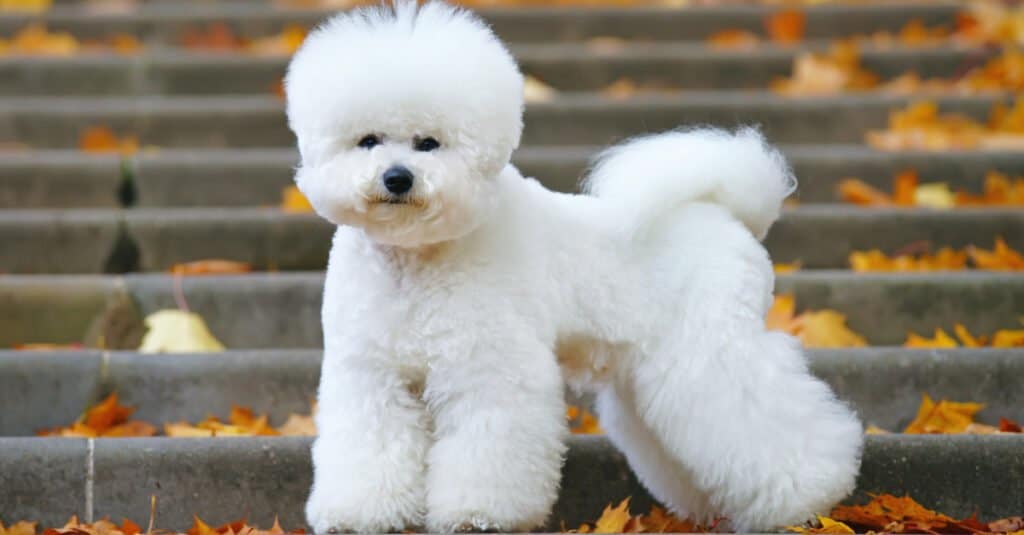
The Bichon Frise is known for being a good companion breed and has long been favored by royalty.
Health and Entertainment for your Bichon Frise
See all of our expert product reviews.
©Eudyptula/Shutterstock.com
Evolution
Royals and aristocrats have loved these little white dogs for millennia. Lap dogs were traded and purchased around the Mediterranean Basin and came to be favored by the likes of Cleopatra and King Henry VIII of England. Bichon Frise is known as a Barbichon-type dog along with the Bolognese, Havanese, and Maltese. It is believed that these breeds began on the island of Tenerife, the largest of the Canary Islands. The Brison Tenerife became the primary ancestor of today’s Bichon Frise.
Around the 13th century, the little white lap dogs began their association with European royalty – including the courts of Italy, France, and Spain. There are many of these pretty little dogs depicted in paintings of the great masters of this era.
After the French Revolution, the once-pampered pets were out on the street on their own. They were so lively and friendly that they caught the eyes of the circus and street performers – and quickly rose to stardom with their natural charisma and abilities to do tricks.
3 Pros and Cons of Owning a Bichon Frise
| Pros! | Cons! |
|---|---|
| Hypoallergenic: Bichon Frises are hypoallergenic and may be a good choice if the dander and hair of other breeds cause allergies for you and your family | Low Guarding Instincts: Bichons do make good watchdogs. They will bark at strangers outside of your home. However, they are a friendly breed and will generally welcome new people once they are in your house. |
| Low to Moderate Activity Level: These dogs are laid back and will mostly get the exercise they need walking around your house. One of their most endearing traits is the Bichon “buzz” where they will excitedly run a circuit throughout your rooms. | Grooming Costs: Bichon Frises do not shed. Because of their thick and cottony hair, you should expect to pay for monthly visits to the groomer. Their white coat also looks best when bathed regularly with brightening shampoo. |
| Trainable: Bichons are eager to please their owners. They are fairly easy to train and enjoy performing tricks in exchange for love and affection. | Can be Difficult to Housebreak: Like many smaller breed dogs, it can take time to housebreak Bichons. Their smaller organs mean that they typically need to go to the bathroom more often than larger dogs, especially when they are young. |
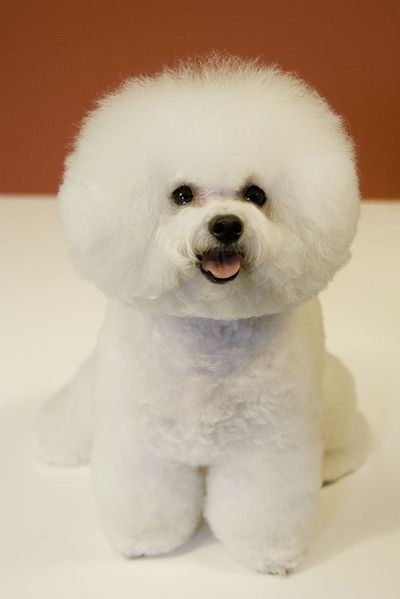
Although small, Bichons are not considered to be a toy breed.
©Akaporn Bhothisuwan, CC BY 2.0, via Wikimedia Commons – Original / License
Size and Weight
Male and female Bichons should both be between 9.5 and 11.5 inches tall. This breed typically weighs between 11 and 18 pounds. However, average size and weight do differ slightly between the sexes. The average height of a male Bichon is 11.8 inches tall while the average height of a female is 10.6 inches tall. Males have an average weight of 15.4 inches while females have an average weight of just over 11 pounds. Even though Bichons are small, they are not small enough to be considered a toy breed.
| Male | Female | |
|---|---|---|
| Height | 9.5 inches to 11.5 inches | 9.5 inches to 11.5 inches |
| Weight | 11 pounds to 18 pounds | 11 pounds to 18 pounds |
Common Health Issues
Bichons are generally a healthy and sturdy breed. They have an average lifespan of between 14 and 15 years. However, with proper care and nutrition, these dogs can live for 19 years or longer.
Despite their long life and typically healthy makeup, Bichons are prone to some potential issues. One of the most common maladies for bichons is skin allergies. Reactions to some proteins or other ingredients in their diet are the most common cause of these allergies.
For example, bichons can be allergic to chicken, beef, or other meat proteins in their food. Signs that your bichon may be allergic to these meats include red, itchy “hot spots” on their skin. Your pet will likely scratch and bite its skin to try and relieve the itching sensation.
Bichons are also frequently allergic to corn or corn meal. Dogs that are allergic to these foods often chew their paws or the fur on their legs. You may also notice a yeasty odor if your Bichon Frise is having an allergic reaction to the corn products in his or her food.
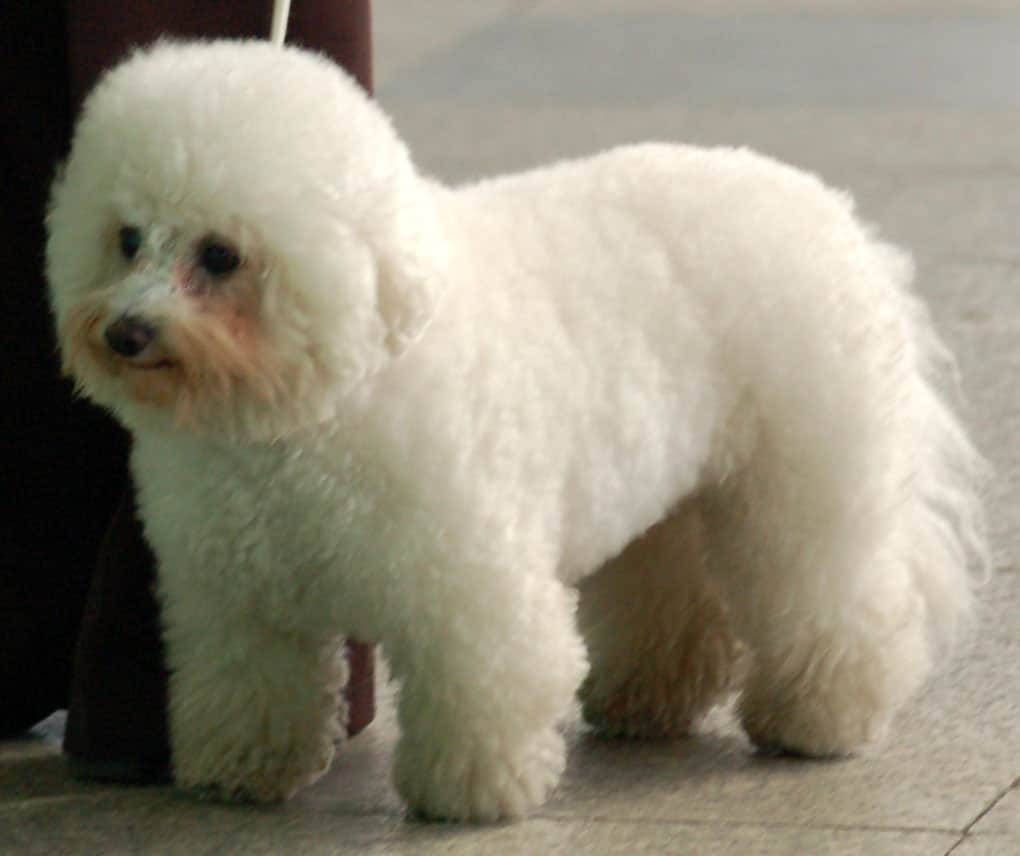
Bichons tend to develop allergies to foods such as corn.
©Lilly M, CC BY-SA 3.0, via Wikimedia Commons – Original / License
These allergy issues are more common with smaller Bichons or ones that were the runts of their respective litters. Liver shunts or other similar problems can contribute to these allergies and lead to liver failure later in life.
Like many other small dog breeds, Bichon Frise dogs can have dental issues. Many veterinarians recommend high-quality kibble combined with dental treats for these dogs to help them clean their teeth. You may also need to brush your furry friend’s teeth one or more times per week to help remove plaque and keep his or her mouth healthy.
Cancer is also another significant health concern for this breed. According to the UK Kennel Club, cancer was the second leading cause of death for Bichons behind old age. However, Bichons who contract cancer generally still live to be 12.5 years old before they succumb to this malady.
In summary, common Bichon Frise health concerns include:
- Food and skin allergies
- Teeth and dental issues
- Cancer
Temperament
A happy demeanor and alert intelligence are two of Bichon Frise’s most well-known behavioral traits. They like to spend time with their families and will follow you from room to room to be close to you. Many people say that their dark, intelligent eyes convey a merry twinkle when they are content. They have been known to “smile” with their tongues partially out when they are truly satisfied.
Because of their personality and a strong desire to please another key trait of this breed is their relative knack for training. However, you may need consistency and patience when it comes to housetraining your new family member.
Learn more about the best dog breeds here.
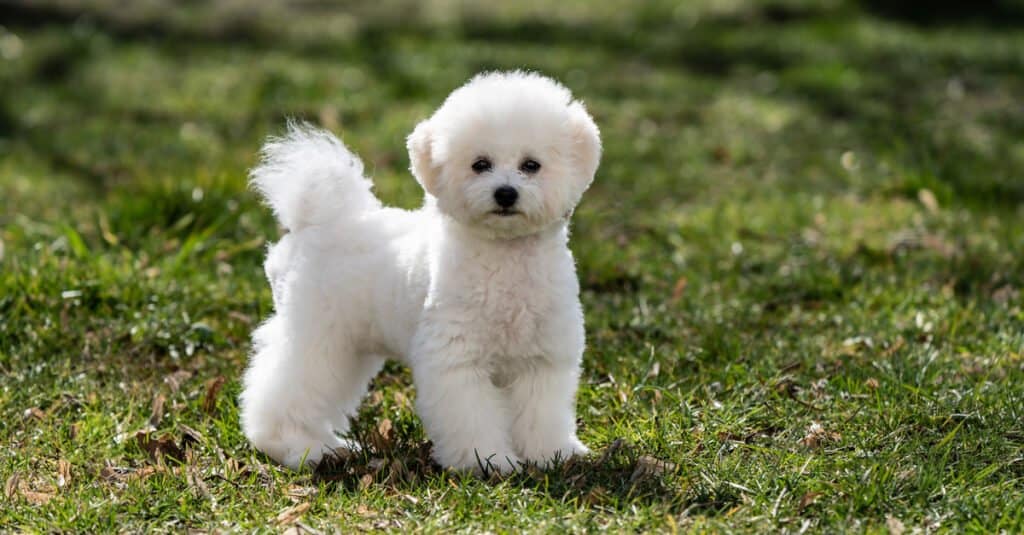
This soft dog breed, the Bichon Frise, is a great choice for someone with allergies.
©Ieva Tvaronavicute/Shutterstock.com
How to Take Care of a Bichon Frise
Because of their happy-go-lucky nature and small size, Bichons generally take care of their own exercise needs by buzzing around your house. However, these dogs do not shed and their curly hair tends to trap dirt and dander. As a result, most breeders recommend daily brushing to remove dead hair and prevent mats or tangles.
If your Bichon suffers from allergies, then he or she may need special hypoallergenic kibble or other limited-ingredient diets. Given their small height, you should also watch your dog’s weight to ensure that it does not put undue stress on its knees. Hips or other joints.
The Best Dog Food for Bichon Frises
Because of their history of food and skin allergies, you should put some careful consideration of the ideal food for your Bichon. Some of these dogs are allergic to chicken, beef, and other traditional proteins found in mass-marketed kibble. If your dog has such allergies, then you may need to consider kibble made from other proteins such as fish, duck, pork, or other, more exotic meats.
Your veterinarian may be able to recommend a hypoallergenic diet if your dog has severe allergies. Many vets recommend kibble over canned wet food for Bichons because the hard morsels can help to remove plaque and other causes of tooth decay.
The good news is that as a small breed, most adult Bichons only require up to one cup of food per day. Due to their smaller stomachs, you might want to split this food into a morning and an evening meal. Eight-week-old puppies should eat every 4-5 hours. You can split one cup of food into quarters and feed your puppy throughout the day.
Keep in mind that it’s best for dogs prone to dental issues like this breed to eat dry kibble rather than wet food. Select a high-quality formula from a reputable manufacturer. You should always read the ingredient label on the bag. If the first ingredients start with cornmeal, chicken meal, or rice as opposed to whole meats, then you may want to look for another option.
At A-Z Animals, we say the best dog food for Bichon Frises is Purina Pro Plan Small Breed Shredded Formula Lamb & Rice Adult Dry Dog Food.
The first ingredient is healthy lamb. The calcium and phosphorus in this food help ensure the strong development and maintenance of bones and teeth. It’s high-protein for high energy levels, nutrient-dense, and full of live probiotics for the gut and immune system. The kibble and the formula are made specifically for dogs under 20 pounds.
Check Chewy and Amazon for these products.
- Nutrient-dense bite-sized kibble and small tender, shredded pieces for a taste and texture dogs love.
- High protein formula with real chicken as the first ingredient.
- Fortified with guaranteed live probiotics to support digestive and immune health.
- Used to be known as SAVOR Shredded Blend Chicken and Rice Formula.
- Formulated high in protein to meet the needs of highly active small dogs.
Maintenance and Grooming
Bichon Frise dogs typically require more grooming than many other dog breeds. These dogs do not shed and therefore will need to be groomed at least once every four to eight weeks. Furthermore, we recommend daily brushing with a slicker brush and a metal come to remove dead hair follicles and to remove tangles.
Insufficient grooming may cause a Bichon Frise to develop mats or clumps of hair close to their skin. These mats can pull on their skin and become uncomfortable over time. Excess or overgrown hair around their mouths can contribute to tooth loss or other dental issues.
Similarly, the hair in a bichon’s ears needs to be plucked regularly to limit the accumulation of dust, dirt, and bacteria. These bacteria can lead to painful ear infections if the hair is not removed.
Due to their soft, white coats, many Bichon owners prefer to bathe their dogs once a month. It is recommended that you use a gentle brightening shampoo to help restore the luster and snowy white color to your dog’s coat. However, bathing your dog too often can remove essential oils and nutrients that help to protect his or her skin.
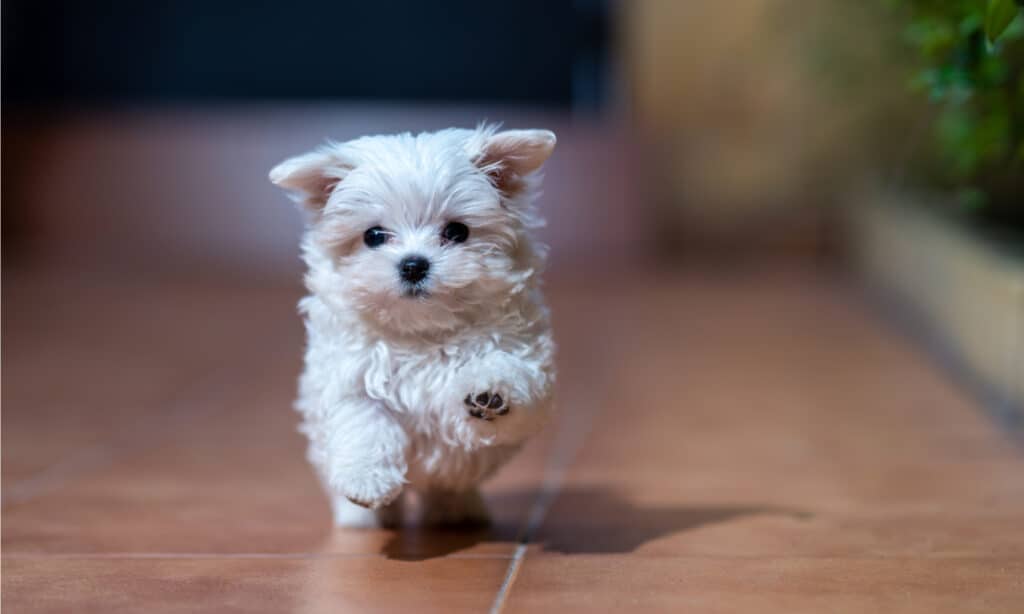
Bichons are highly trainable and should start when they are puppies.
©Francisco Gomez Perpinan/Shutterstock.com
Training
Bichon Frise dogs are relatively easy to train. They like to get attention from their families and friends and will be more than happy to do some tricks. This breed’s bubbly personality means that they often love to get dressed up in costumes or outfits for the holidays.
Exercise
As noted above, Bichons are a non-sporting breed and are not overly active. They generally take care of their needs by walking or running around the house. Short walks two or three times per day to go to the bathroom should be enough exercise for this breed.
Puppies
Bichon Frise puppies are cute cotton balls that love to play. They typically come in white, cream, or apricot colors. Their eyes should be dark black and their noses and lips should also be black as opposed to brown.
Because of their small size, housetraining a Bichon Frise can be a challenge. Their small bladders and other organs mean that you will need to take them out more frequently than other, larger breeds. Some owners note that it can take one year or more to fully potty-train your Bichon and avoid accidents in the house.
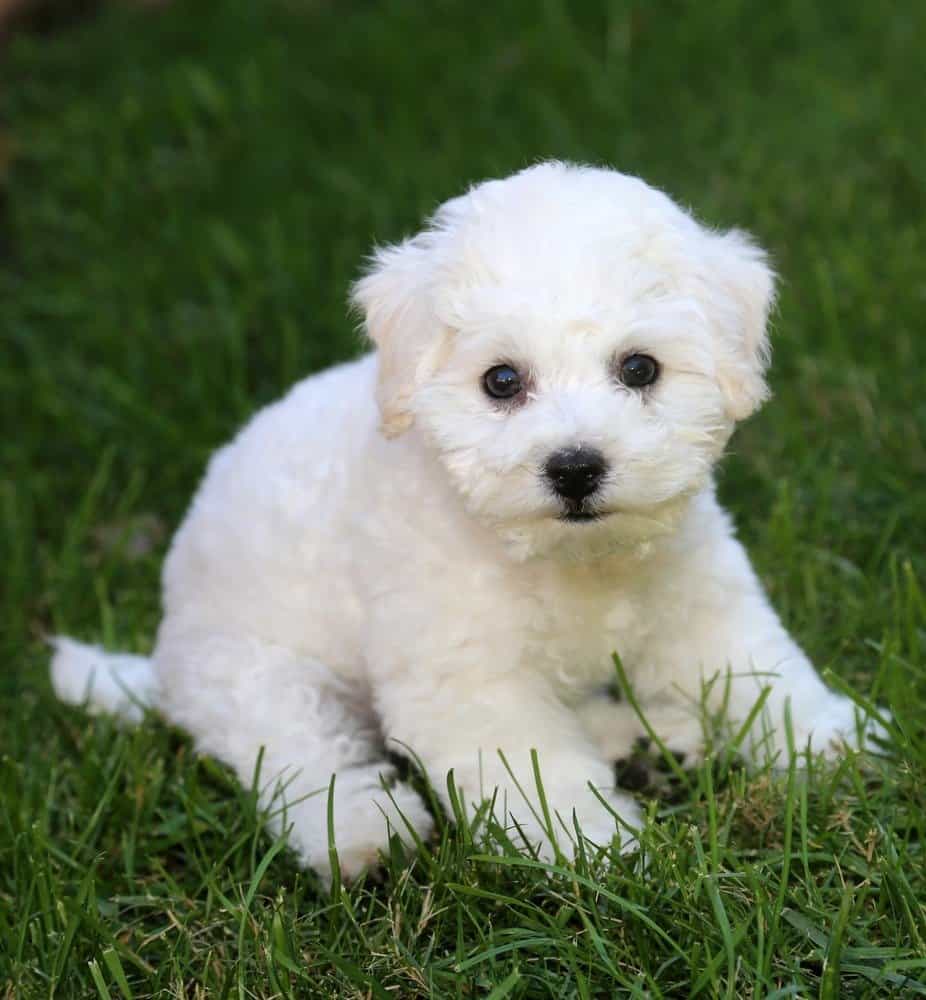
Bichons are a great choice for families with limited space.
©mikeledray/Shutterstock.com
Bichon Frises And Children
Bichons usually have a laid-back and happy-go-lucky demeanor. As a result, they are a great choice for families living in the city, apartments, or houses with limited outdoor space. While these dogs are generally sturdy, they are small. Toddlers and young children could inadvertently step on or otherwise hurt your Bichon while they are learning to play.
You may want to wait until your children are older before you decide to add this breed to your family. These dogs are also highly social and love being with their humans. Many discerning breeders will require that someone be at home with the puppy or that you have a plan in place so that your Bichon is not left alone for extended periods of time.
Dogs similar to Bichon Frise
Other breeds that have similar traits to the Bichon Frise include the Bolognese, the Maltese, and the Havanese.
- Bolognese: Bichon Frise and Bolognese dogs are both small breed dogs with a height of 12 inches or less. While Bichons are typically 12 to 18 pounds Bolognese is only 5.5 to 9 pounds in weight. Bolognese is also easy-going playful and affectionate with their human families, just like Bichon Frises.
- Maltese: Maltese dogs are also well-known for their coats. However, while the Bichon Frise has a soft and cotton-like curly coat, the Maltese’s coat normally is straight and silky. Many owners keep their Maltese dogs with long coat that touches the ground. These dogs are also normally white with dark eyes and noses. They have a similar lifespan to the Bichon of 12 to 15 years. Yet Maltese are shorter and lighter at a maximum of nine inches and 7 pounds, respectively.
- Havanese: The Havanese is the only known dog species to originate on the island of Cuba. Like the French Bichon Frise, these dogs are intelligent and friendly dogs. They have a comical personality and are most happy around their friends and family. Havanese are also a non-sporting breed, like Bichons. According to the AKC breed standard, Havanese are between 8.5 and 11.5 inches tall and weigh between seven and 13 pounds. They, like the Bichon, are long-lived with an average lifespan between 14 and 16 years.
Famous Bichon Frises
Bichons have been a popular dog breed for many years. Because of this, there are lots of Bichons with famous owners, both now and in the past.
- Sammy was Barbara Streisand’s Bichon. Two days after his death in 2003, she recorded a version of the song ‘Smile’ for him.
- Buddy was Demi Lovato and Wilmer Valderrama’s Bichon Frise.
- King Henry III of England and King Francis I of France both had Bichon Frises in the 16th century.
Popular Names for Bichon Frise
Looking for the perfect name for your Bichon? Below are some popular names you can choose from.
- Peanut
- Nipper
- Squirt
- Bonbon
- Button
- Cuddles
- Bailey
- Angel
- Misty
Bichon Frise FAQs (Frequently Asked Questions)
How much does Bichon Frise cost to own?
The cost of purchasing a Bichon from a breeder can vary quite a bit. You may be able to find some dogs that cost around $1,000, while others could be more than $3,000. Finding a well-trained Bichon with a healthy bloodline will cost more. If you find a Bichon to adopt from a rescue organization or shelter, you can expect to pay a few hundred dollars in adoption fees.
If you’re thinking about bringing a Bichon Frise home, you will also want to budget for other expenses associated with caring for a dog. These can include training, veterinary bills and vaccinations, accessories, food, and treats. You’ll likely spend the most money the first year you own your dog, and everything could easily add up to over $1,000 or even $2,000. Subsequent years should cost less, but you’ll always want to be prepared for unexpected expenses, so budgeting at least $500 to $1,000 is a good idea.
How long does Bichon Frise live?
The average life expectancy of a Bichon Frise is between 14 and 15 years.
How do you pronounce Bichon Frise?
Bichon Frise is pronounced BEE-SHON FREE-ZAY.
Is a Bichon Frise a good family dog?
Yes, Bichon Frises can make a great family dog. They are loving and tolerant of children. They may run around with the kids in a family or cuddle up next to them on the couch.
Since Bichons are smaller and could be easily injured, you will want to make sure children know how to appropriately interact with them. Children, especially young children, should always be closely supervised when they are around Bichons or other dog breeds.
How big does a Bichon Frise get?
While not a toy breed, Bichon Frises are small dogs. They are generally between 9.5 and 11.5 inches tall and weigh between 12 and 18 pounds.
What health problems do Bichon Frises have?
Bichon Frises are normally a very long-lived and hearty breed. However, they can suffer from food and skin allergies, ear infections, dental issues, and cancer.
Are Bichon Frises herbivores, carnivores, or omnivores?
Bichon Frises are Omnivores, meaning they eat both plants and other animals.
What Kingdom do Bichon Frises belong to?
Bichon Frises belong to the Kingdom Animalia.
What class do Bichon Frises belong to?
Bichon Frises belong to the class Mammalia.
What phylum to Bichon Frises belong to?
Bichon Frises belong to the phylum Chordata.
What family do Bichon Frises belong to?
Bichon Frises belong to the family Canidae.
What order do Bichon Frises belong to?
Bichon Frises belong to the order Carnivora.
What genus do Bichon Frises belong to?
Bichon Frises belong to the genus Canis.
What type of covering do Bichon Frises have?
Bichon Frises are covered in Hair.
How many babies do Bichon Frises have?
The average number of babies a Bichon Frise has is 4.
What is an interesting fact about Bichon Frises?
Bichon Frises are gentle mannered, playful, and affectionate!
What is the scientific name for the Bichon Frise?
The scientific name for the Bichon Frise is Canis lupus.
What's the difference between the Bichon Frise and the Coton De Tulear?
The Bichon Frise is slightly larger than the Coton De Tulear, though the Coton De Tulear has a slightly longer lifespan than the Bichon Frise. These two dog breeds also have different types of fur, though they are equally soft!
What's the difference between the Bichon Frise and the Poodle?
The poodle comes in more colors than the Bichon Frise. Additionally, the Bichon Frise was bred to hunt rats, while the poodle was bred as a gun and performance dog.
Thank you for reading! Have some feedback for us? Contact the AZ Animals editorial team.
Sources
- David Burnie, Dorling Kindersley (2011) Animal, The Definitive Visual Guide To The World's Wildlife / Accessed November 10, 2008
- Tom Jackson, Lorenz Books (2007) The World Encyclopedia Of Animals / Accessed November 10, 2008
- David Burnie, Kingfisher (2011) The Kingfisher Animal Encyclopedia / Accessed November 10, 2008
- David Burnie, Dorling Kindersley (2008) Illustrated Encyclopedia Of Animals / Accessed November 10, 2008
- Dorling Kindersley (2006) Dorling Kindersley Encyclopedia Of Animals / Accessed November 10, 2008
- American Kennel Club / Accessed November 9, 2020
- Wikipedia / Accessed November 9, 2020
- Bichon Frise Club of America / Accessed November 9, 2020
- PetMD / Accessed November 9, 2020



















